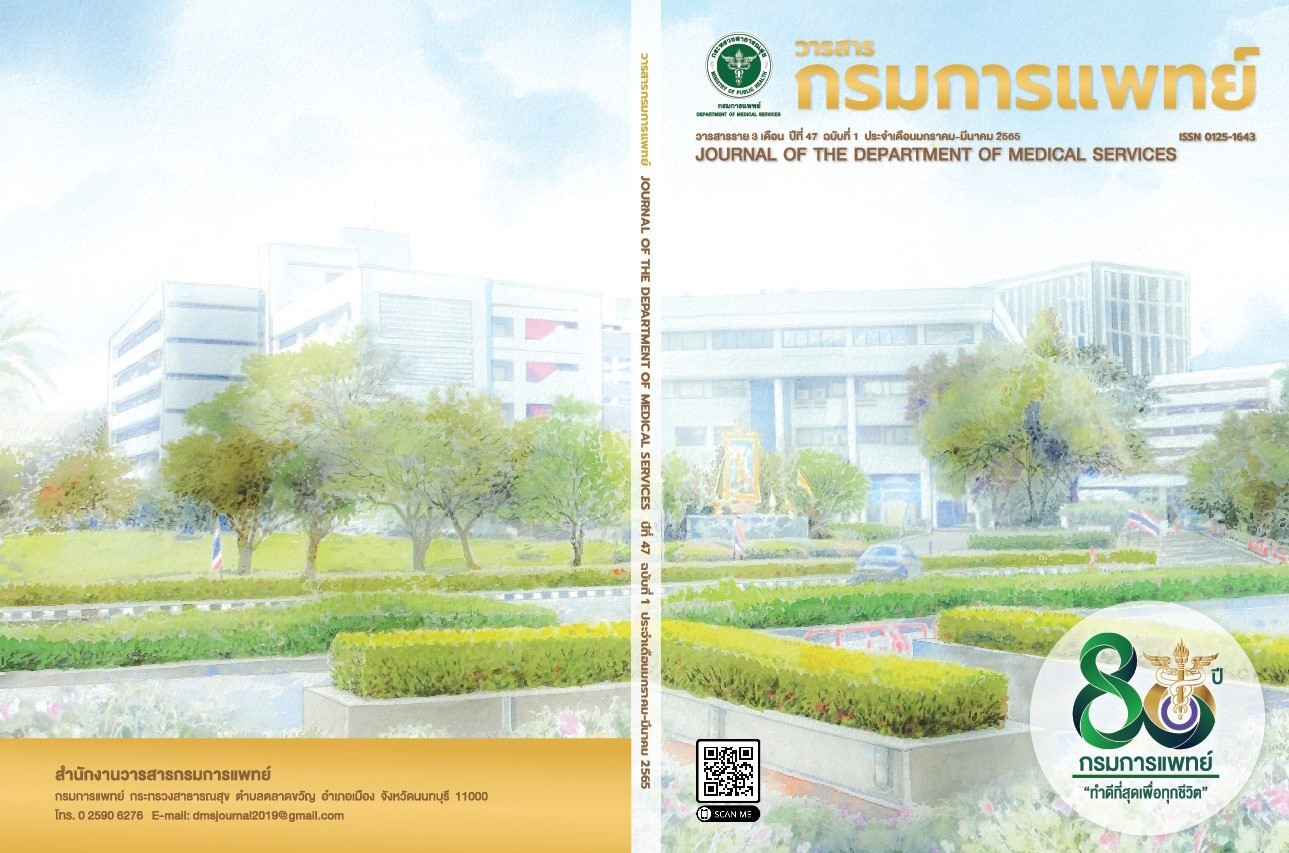Measurement of Patient Radiation Doses from Digital radiography (DR) for Chest X-ray Examination using optically stimulated luminescence nanoDot dosimeter.
Keywords:
Entrance Surface Air Kerma, Chest X-ray, nanoDot, Digital RadiographyAbstract
Background: Patient radiation doses resulting from X-ray examinations depend on both the X-ray imaging technology and the exposure parameter settings.Objective: This research aimed to determine the optimum x-ray parameters and to evaluate the entrance surface air kerma (ESAK) for patients undergoing chest x-ray examination using digital radiography (DR) system.Method: The determination of the optimum x-ray parameters, the x-ray images of a chest phantom were taken and the radiation output and image quality in terms of signal to noise ratio (SNR) and contrast to noise ratio (CNR) from different combinations of tube voltage (kVp) and tube current-time products (mAs) were evaluated with and without using radiographic grid. For the evaluatation of the patient’s ESAK, the optical stimulated luminescent (OSL) nanoDotÒ dosimeters were applied to the skin of 86 patients of standard size at the center of x-ray beam during the x-ray examination.Results: The results revealed that the optimum x-ray parameters, of which the high image quality at low dose is obtained, were 73 kVp, 200 mA, 0.032 second exposure time, 180 cm source to image receptor distance (SID) and exposed without using grid. The mean ESAK for the patients was 0.19 ± 0.011 mGy. The air kerma measured using OSL nanoDot and using ionization chamber type X2 R/F sensor were 0.10 ± 0.0022 mGy and 0.09 ± 0.0013 mGy respectively.Conclusion: The mean ESAK for the patients was significantly lower than that of the national dose reference level of 0.29 mGy. The air kerma measured using OSL nanoDot was significantly lower than that obtained from the ionization chamber type X2 R/F sensor (p ‹ 0.05). The patient’s ESAK should be assessed regularly by the radiological technologist in order to ensure that the patient's radiation dose is acceptable and the image quality is sufficient for physician's diagnosis.
References
International Commission on Radiological Protection. Radiological Protection and Safety in Medicine. ICRP Publication 73. Annals of ICRP 1996; 26:1-47.
The Japan Medical Imaging and Radiological Systems Industries Association and the National Institute of Radiological Sciences. Diagnostic Reference Levels Based on Latest Surveys in Japan [Internet]. 2015[cited 2018 August 10]. Available from: http:// www.radher.jp/J-RIME/report/DRLhoukokusyoEng.pdf
Tongruang C, Theirrattanakul S, Diswath W. Characterization of an Optically Otimulated Luminescence NanoDot Dosimeters for Diagnostic Radiology. Bulletin of the Department of Medical Science 2016; 58:141-48.
European Commission. European Guidelines on Quality Criteria for Diagnostic Radiographic Image [Internet]. 1996 [cited 2018 August 20]. Available from: https://seram.es/images/site/129_ eur16260.pdf.
Banjong Kheonkaew. Digital Radiography. 2nd ed. Khon Kaen: Faculty of Medicine Khon Kaen University; 2018.
National Electronics and Computer Technology Center. SizeThailand [Internet]. 2000 [cited 2019 August 20]. Available from: http://www.sizethailand.org/region_all.html
Tengchaiyapoom J, Wibuluthai J, Hanpanich P. The Study of Relationship of Appropriate Radiation Dose Following Standard Criteria and Radiography Exposure Technique in Nongsung Hospital, Mukdaharn province. Journal of Medicine and Health Science 2020; 27:111-22.
Yensri L. Comparison of radiation absorbed doses among patients undergoing standard chest radiographic examination by Computed Radiography (CR) and Digital Radiography (DR). The Southern College Network Journal of Nursing and Public Health 2016; 3:129-39.
Buncharat S, Hamuttiti P. Patient doses in simple radiographic examinations in Trang, Phatthalung and Satun provinces in the transition from x-ray film to Computed Radiography. Journal of Health Science 2016; 25:632-40.
Wutthisas J, Natheetorn C, Srisook A. Assessment of Entrance Skin Dose and Organ Dose of Radiation in Patients Receiving Chest X-ray Using PCXMC 2.0. Journal of Health Science 2014; 23:704-11.
Department of Medical Sciences,Ministry of public health.
Diagnostic reference level in general radiography [Internet]. 2017 [cited 2020 September 10]. Available from: webdb.dmsc.moph. go.th/radiation/งานรังสีวินิจฉัย/ค่าปริมาณรังสีอ้างอิงgen-final.pdf.
Downloads
Published
How to Cite
Issue
Section
License
Copyright (c) 2022 Department of Medical Services, Ministry of Public Health

This work is licensed under a Creative Commons Attribution-NonCommercial-NoDerivatives 4.0 International License.
บทความที่ได้รับการตีพิมพ์เป็นลิขสิทธิ์ของกรมการแพทย์ กระทรวงสาธารณสุข
ข้อความและข้อคิดเห็นต่างๆ เป็นของผู้เขียนบทความ ไม่ใช่ความเห็นของกองบรรณาธิการหรือของวารสารกรมการแพทย์



